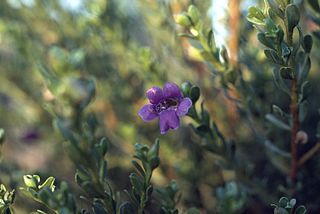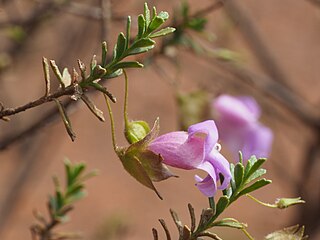
Eremophila clarkei, commonly known as turpentine bush, is a flowering plant in the figwort family, Scrophulariaceae and is endemic to Western Australia, South Australia and the Northern Territory. It is a shrub which is variable in form, but usually with narrow leaves and white or pale pink flowers. It is similar to Eremophila georgei and Eremophila granitica.
Eremophila appressa, commonly known as wispy poverty bush, is a plant in the figwort family, Scrophulariaceae and is endemic to two remote locations in the central west of Western Australia. Its most unusual feature is its leaves which, at least when young, are less than 2.5 mm (0.1 in) long and 1 mm (0.04 in) wide and are glued to the stem by resin.
Eremophila falcata is a flowering plant in the figwort family, Scrophulariaceae and is endemic to Western Australia. It is a widely distributed shrub with distinctive curved leaves and white, lilac-coloured or pink flowers.

Eremophila flabellata is a flowering plant in the figwort family, Scrophulariaceae and is endemic to Western Australia. It is a small shrub with serrated leaves, broad serrated sepals and pink, purple or mauve flowers.

Eremophila incisa is a flowering plant in the figwort family, Scrophulariaceae and is endemic to Western Australia. It is a low shrub with shiny leaves which have thickened teeth along their edges and hairy, mauve or purple flowers.
Eremophila lucida, commonly known as shining poverty bush, is a flowering plant in the figwort family, Scrophulariaceae and is endemic to Western Australia. It is an erect shrub with sticky, shiny leaves and branches and with flowers that are either red with darker red blotches inside or cream-coloured without spots or blotches.
Eremophila papillata is a flowering plant in the figwort family, Scrophulariaceae and is endemic to Western Australia. It is an erect, compact shrub with sticky, narrow leaves and mauve, blue or purple, rarely white flowers.
Eremophila petrophila is a flowering plant in the figwort family, Scrophulariaceae and is endemic to Western Australia. It is a tall, erect, open shrub with rough branches, narrow, sticky leaves and pale lilac-coloured flowers.

Eremophila phyllopoda is a flowering plant in the figwort family, Scrophulariaceae and is endemic to Western Australia. It is an erect or spreading shrub, sometimes round or flat-topped with sticky, hairy leaves and flowers ranging in colour from pink or lilac to purple.

Eremophila platythamnos, commonly known as desert foxglove, is a flowering plant in the figwort family, Scrophulariaceae and is endemic to Australia. It is an erect shrub with short, broad leaves and purple, mauve, blue or pink flowers.
Eremophila praecox is a flowering plant in the figwort family, Scrophulariaceae and is endemic to Australia. It is a small, broom-like shrub with small leaves and purple and white flowers.
Eremophila prolata is a flowering plant in the figwort family, Scrophulariaceae and is endemic to Western Australia. It is an erect shrub with a rounded top, prominently ridged, hairy branches, narrow leaves and white to deep lilac-coloured flowers.

Eremophila punctata is a flowering plant in the figwort family, Scrophulariaceae and is endemic to Western Australia. It is an erect shrub with sticky young branches and leaves due to the presence of resin. Its small leaves usually have a few blunt teeth near their ends and flowers which are usually lilac-coloured. It is a distinctive and widespread species.
Eremophila rostrata is a flowering plant in the figwort family, Scrophulariaceae and is endemic to Western Australia. It is an erect shrub with cylinder-shaped leaves, small sepals and glabrous, pink to deep red petals. There are two subspecies, both of which are critically endangered.
Eremophila setacea is a flowering plant in the figwort family, Scrophulariaceae and is endemic to Western Australia. It is an erect shrub with narrow, glabrous leaves, hairy sepals and light blue to purple petals.
Eremophila shonae is a flowering plant in the figwort family, Scrophulariaceae and is endemic to Western Australia. It is an erect shrub or a low spreading shrub, depending on subspecies and has very sticky branches and leaves due to the presence of large amounts of resin. The leaves are narrow and the flowers are mauve to purple and white inside with purple spots.

Eremophila spectabilis, commonly known as showy poverty bush, is a flowering plant in the figwort family, Scrophulariaceae and is endemic to Western Australia. It is a dense, erect shrub with narrow, greyish leaves and blue, mauve or purple flowers.
Eremophila spongiocarpa is a flowering plant in the figwort family, Scrophulariaceae and is endemic to Western Australia. It is a compact shrub with many tangled branches, flattened, succulent leaves, hairy sepals and creamy white petals which are spotted red on the inside.
Eremophila succinea is a flowering plant in the figwort family, Scrophulariaceae and is endemic to Western Australia. It is an erect, broom-shaped shrub with sticky, narrow, hooked leaves, narrow, sticky sepals and hairy, pale purple or mauve petals.
Eremophila viscimarginata is a flowering plant in the figwort family, Scrophulariaceae and is endemic to Western Australia. It is a small, erect, prickly shrub with hairy stems, small leaves, greenish-pink sepals and mauve petals.









